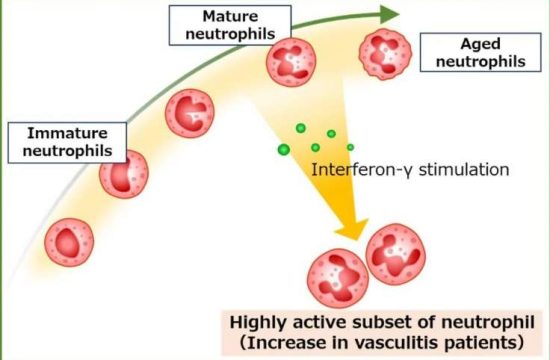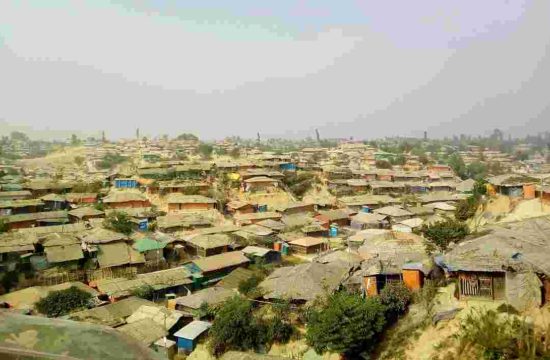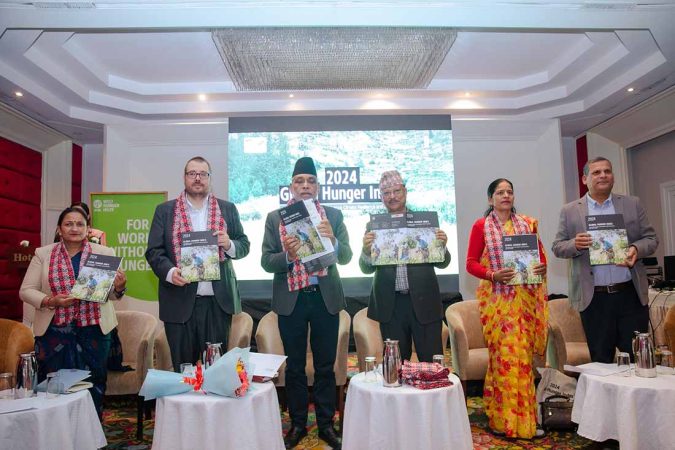
Lalitpur— The ‘2024 Global Hunger Index’ report has been made public in Nepal, and measures to avoid hunger have been discussed. Welthungerhilfe (WHH) Nepal and the Local Initiative for Biodiversity, Research, and Development (LI-BIRD) jointly organized this event in Lalitpur on Friday, April 4, 2025.
The organizers stated that the Global Hunger Index (GHI) is an annual, peer-reviewed report published by Welthungerhilfe and Concern Worldwide. This year’s report highlights the critical role of gender justice in strengthening climate resilience and ensuring food and nutrition security.
In 2024, the Institute for International Law of Peace and Armed Conflict (IFHV) joined as a new partner, contributing to the calculation and development of the index moving forward. Based at Ruhr-University Bochum, IFHV is one of Europe’s leading academic institutions specializing in humanitarian crisis research.
Nepal ranks 68th with a GHI score of 14.7, reflecting a 30% improvement since 2016, though child stunting remains a critical concern. Furthermore, this time the event will focus on the role of gender justice in enhancing climate resilience and achieving zero hunger.
Releasing the report, Minister for Agriculture and Livestock Development Ramnath Adhikari said, “The ministry is committed to sustainable development, reducing the use of harmful chemicals that have environmental and human impacts.”
“Nepal has emphasized the use of botanical organic fertilizers by farmers to maintain food security and reduce child malnutrition,” he added. “The ministry is working to ensure access to agriculture for women and marginalized communities. The improvement in hunger can be seen as a result.”
Hunger and Its Measure
According to the report, the hunger score is measured based on four key indicators: Undernourishment: The share of the population with insufficient caloric intake for a healthy, productive life; Child Stunting: The percentage of children with low height for age, reflecting chronic undernutrition; Child Wasting: The percentage of children with low weight for height, indicating acute undernutrition; Under-Five Mortality Rate: The percentage of children who die before the age of five, the most severe consequence of hunger and undernutrition. GHI scores range from 0 to 100, where 0 represents no hunger and 100 indicates extreme hunger.
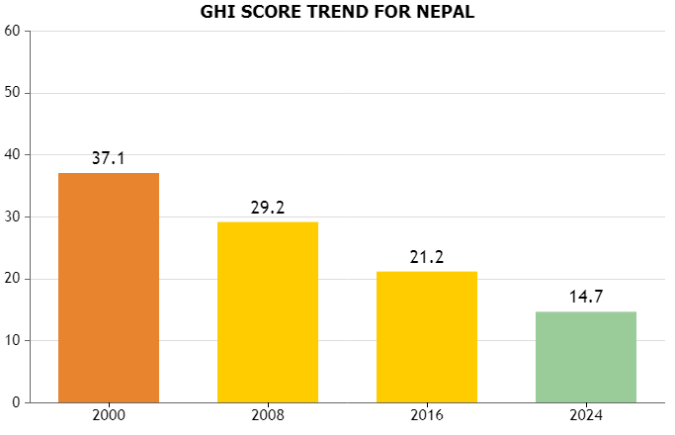
In Nepal, 5.7 percent of the population is undernourished, 24.8% of children under five are stunted, 7.0% of children under five are wasted, and 2.7% of children die before their fifth birthday.
In 2000, 2008, and 2016, undernutrition was around 60, 50, and 40 percent, respectively. Although there has been improvement in recent years, experts say that it has contributed to the increase in the hunger index, reaching 24.7 percent in 2024.
According to experts, Nepal has not been able to achieve complete success in food and nutrition security due to poor-quality food, child undernutrition, economic challenges, and natural disasters.
“One in four children is affected by undernutrition,” said Shakeb Nabi, director of Welthungerhilfe (WHH) Nepal. He emphasized that Nepal needs to work more on climate resilience and zero hunger as climate change increases risks to food security.
Hunger in South Asia and Nepal
Hunger remains a pressing issue in South Asia, characterized by rising undernourishment and persistently high rates of child undernutrition. Poor diet quality, economic hardships, and increasing natural disasters further exacerbate these challenges.
In 2024, Nepal’s GHI score is 14.7, placing the country in the moderate hunger category. This marks a significant improvement from 2000, when Nepal’s score was 37.1, falling into the alarming category. This progress is largely due to a substantial reduction in child stunting. However, the issue persists, with one in four Nepali children still affected. Meanwhile, global progress in addressing hunger has stagnated since 2016.
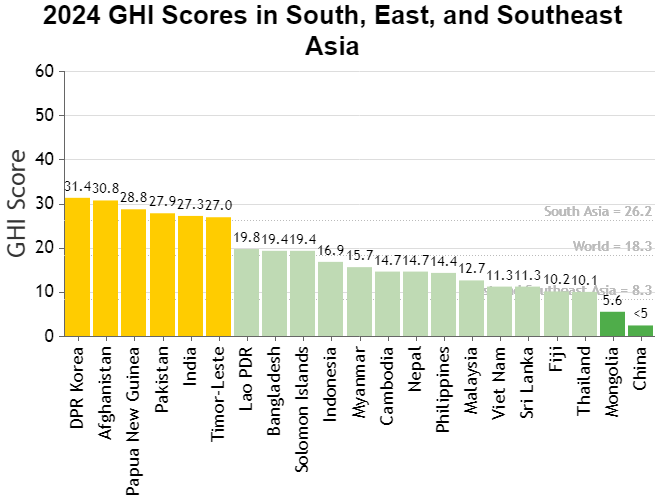
Zero Hunger Goal Setting
The report notes that hunger rates have increased in some countries of the world, including Nigeria and Ghana, compared to the previous year. Gender inequality and environmental risks have increased in the region. Therefore, experts have emphasized that only gender equality and justice will help in achieving the goal of zero hunger.
Former Foreign Minister Dr. Bimala Rai Paudyal said, “Women should be given a leadership role to achieve zero hunger and food security.”
Women are participating in agricultural production, but their skills and leadership roles are declining, so the government will have to do more, said former Minister Rai. She also said that agricultural production is low and expensive due to the depletion of water resources due to climate change.
Roadmap for the Agroecology
Dr. Ramkrishna Shrestha, Joint Secretary, Ministry of Agriculture, gave an oral presentation on the concept of the Ecological Agriculture Roadmap. He said, “It will set the goal of improving livelihoods for small and marginal farmers by building sustainable, inclusive, and food system resilience.”
Benjamin Seidel, deputy chief of mission at the German Embassy, noted that the challenge of global hunger due to climate change must be addressed through international cooperation. He emphasized the role of women’s agro-entrepreneurship in reducing malnutrition among children.
Birendranagar Municipality Mayor Mohan Maya Dhakal said that Karnali is the most vulnerable region to climate change. She stressed the urgent need for coordination among all three levels of government to implement climate-resilient programs.
Dr. Doj Raj Khanal, executive director of the Agricultural Research Council (NARC), said that a policy is needed to encourage youth to return to agriculture by focusing on sustainability rather than mechanization.
Gauri Dahal, a farmer from a remote area of Shurkhet, Nepal, shared her experience of benefiting from learning and using knowledge, skills, and technology from LI-BIRD to practice organic farming under the Harit Karnali Project. She said, “Our group has conserved indigenous seeds locally.”
Discussion on ways to avoid hunger
Pragya Devkota of the World Food Forum urged the government to provide access to technology and concessional loans to bridge the digital and economic divide.
Sita Pandey, chief manager of Muna Bazaar, emphasized the use of data to improve nutrition, empower women, enhance biodiversity, and guide agricultural policies and decision-making processes.
Dr. Hari Bahadur KC, Joint Secretary, Ministry of Agricultural Development, discussed the ongoing efforts to localize food production and consumption. He shared his experience with the work done on agricultural insurance and the promotion of high-value crops.
Sharmila Pun, a technical expert at WHH Nepal, emphasized the need to address structural inequalities in the food system, saying, “Identity, redistribution, and representation must guide our approach to climate and food justice.”
Concluding the panel, Dr. Kiran Rupakheti said, “Inter-ministerial collaboration, thoughtful land use planning, and strategies should be developed to retain youth in agriculture.”
Dr. Pratap Kumar Shrestha, president of LI-BIRD, concluded the program by mentioning the work being done in various sectors of agriculture to combat climate change in Nepal.



